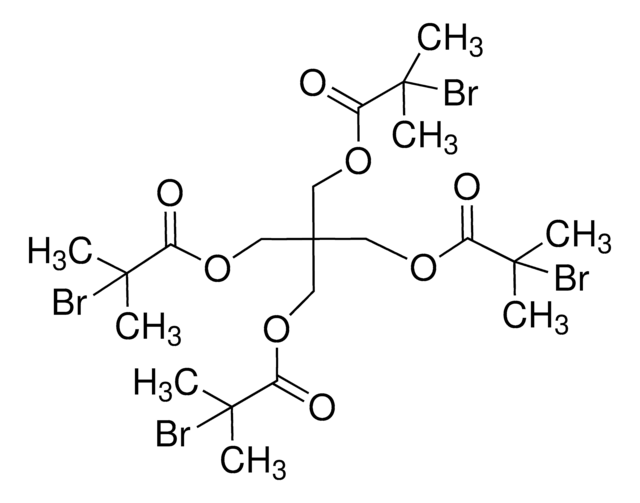734586
2-(2-Bromoisobutyryloxy)ethyl methacrylate
95%
Synonym(e):
2-Methacryloxyethyl 2′-bromoisobutyrate, 2-Methylacrylic acid 2-(2-bromo-2-methylpropionyloxy) ethyl ester, BIEM
About This Item
Empfohlene Produkte
Assay
95%
Form
liquid
Brechungsindex
n20/D 1.471
Dichte
1.303 g/mL at 25 °C
Lagertemp.
2-8°C
SMILES String
CC(=C)C(=O)OCCOC(=O)C(C)(C)Br
InChI
1S/C10H15BrO4/c1-7(2)8(12)14-5-6-15-9(13)10(3,4)11/h1,5-6H2,2-4H3
InChIKey
QXDYJUSFCUKOQD-UHFFFAOYSA-N
Verwandte Kategorien
Anwendung
Analysenzertifikate (COA)
Suchen Sie nach Analysenzertifikate (COA), indem Sie die Lot-/Chargennummer des Produkts eingeben. Lot- und Chargennummern sind auf dem Produktetikett hinter den Wörtern ‘Lot’ oder ‘Batch’ (Lot oder Charge) zu finden.
Besitzen Sie dieses Produkt bereits?
In der Dokumentenbibliothek finden Sie die Dokumentation zu den Produkten, die Sie kürzlich erworben haben.
Kunden haben sich ebenfalls angesehen
Artikel
Over the past two decades, the rapid advance of controlled living polymerization (CLP) techniques.
Protokolle
Polymerization via ATRP procedures demonstrated by Prof. Dave Haddleton's research group at the University of Warwick.
Unser Team von Wissenschaftlern verfügt über Erfahrung in allen Forschungsbereichen einschließlich Life Science, Materialwissenschaften, chemischer Synthese, Chromatographie, Analytik und vielen mehr..
Setzen Sie sich mit dem technischen Dienst in Verbindung.![(R)−RuCl[(p−cymene)(DM−BINAP)]Cl](/deepweb/assets/sigmaaldrich/product/structures/172/736/7aee8e58-7060-48ab-9da3-e0ce8eeab5ff/640/7aee8e58-7060-48ab-9da3-e0ce8eeab5ff.png)




![Pentaerythritol tetrakis[2-(dodecylthiocarbonothioylthio)-2-methylpropionate] 97% (HPLC)](/deepweb/assets/sigmaaldrich/product/structures/234/301/a6e20d26-df1b-49c6-bdee-c98dd3488cc2/640/a6e20d26-df1b-49c6-bdee-c98dd3488cc2.png)


![[2-(Methacryloyloxy)-ethyl]-dimethyl-(3-sulfopropyl)-ammoniumhydroxid 95%](/deepweb/assets/sigmaaldrich/product/structures/217/219/73c91e1c-0ee4-4b3d-bead-a6dc3d09d1da/640/73c91e1c-0ee4-4b3d-bead-a6dc3d09d1da.png)





